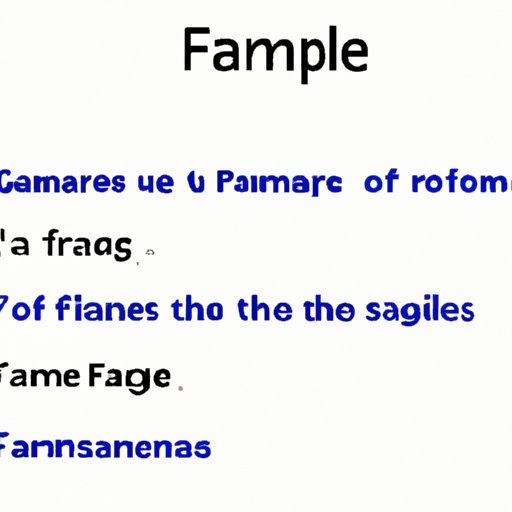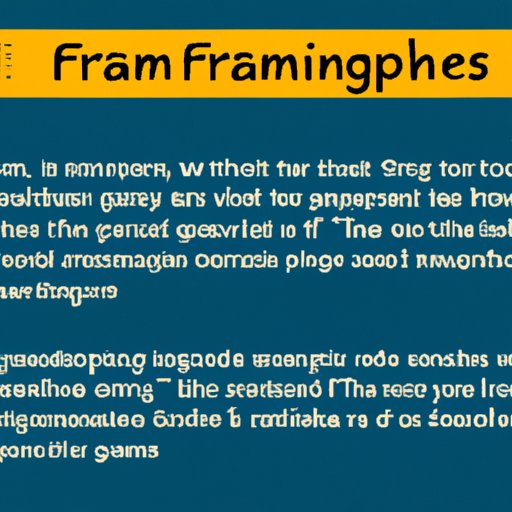Introduction
Fragments in literature are phrases or sentences that don’t form a complete thought. They are often used to add emphasis or create tension in a story. While most commonly found in poetry and short stories, fragments can also be used in novels and other forms of writing. It’s important to understand what constitutes a fragment and how to identify them when reading or writing.
Overview of Fragments in Literature
Understanding what a fragment is and how it’s used in literature is essential for appreciating the power of this type of writing. Let’s take a look at some common questions about fragments:
What is a Fragment?
A fragment is a phrase or sentence that doesn’t form a complete thought. It usually consists of a single subject and verb but lacks the rest of the components of a complete sentence. Fragments are usually used to emphasize a point or create tension.
Types of Fragments
Fragments come in many forms. They can be single words, phrases, or incomplete sentences. They can also be used as part of a larger sentence or stand alone. For example, a fragment could be a single word like “never” or an incomplete sentence like “Running through the woods.”
How Fragments are Used in Writing
Fragments are commonly used in poetry and short stories because they can help create a mood or atmosphere. They are also sometimes used in longer forms of writing such as novels. In these cases, they can be used to add emphasis or create tension.

Common Examples of Fragment Usage
Let’s look at some examples of how fragments are used in literature:
Short Stories
In short stories, fragments can be used to draw attention to a particular event or emotion. For example, if the protagonist is feeling overwhelmed, the author might use a fragment like “Too much.” This draws the reader’s attention to the character’s feelings and creates tension in the story.
Poetry
Fragments are often used in poetry to create a rhythm or flow. For example, a poet might use a fragment like “The sun setting” to emphasize the beauty of the moment. The fragment helps to capture the feeling of the moment in just a few words.
Novels
Fragments can also be used in novels to add emphasis or create tension. For example, if a character is making an important decision, the author might use a fragment like “Now or never.” This will draw the reader’s attention to the significance of the moment.

How to Identify Fragments in Writing
When reading, it’s important to be able to identify fragments so you can understand their purpose in the story. Here are some tips for identifying fragments:
Analyzing Grammar and Word Choices
Often, fragments will lack the necessary grammar components of a complete sentence. For example, a fragment might lack a subject or verb. Paying attention to the grammar and word choices in a sentence can help you identify fragments.
Examining the Context
Fragments can also be identified by examining the context in which they are used. If a phrase or sentence seems to emphasize a particular emotion or event, it’s likely a fragment. Understanding the context of a fragment will help you appreciate its impact on the story.
The Pros and Cons of Using Fragments
While fragments can be a powerful tool in storytelling, there are both pros and cons to using them. Let’s take a look at some of the benefits and drawbacks of using fragments:
Pros
Fragments can be used to add emphasis or create tension in a story. They also help to keep the reader’s attention and draw them into the story. Fragments can also be used to convey a character’s emotions without having to explain them in detail.
Cons
Fragments can also be confusing for readers if they aren’t used correctly. They can also make a story seem choppy or disjointed if not used properly. Finally, fragments can make the text harder to read since they don’t provide complete thoughts.

The Power of Fragments: How They Enhance a Story
When used correctly, fragments can be a powerful tool in storytelling. Here are some ways in which fragments can enhance a story:
Adding Emphasis
Fragments can be used to emphasize a particular emotion or event. This can help the reader to understand the importance of the moment and draw them into the story.
Creating Tension
Fragments can also be used to create tension in a story. By emphasizing a particular moment or emotion, the reader will be left wondering what will happen next.
Showing Character Development
Fragments can also be used to show a character’s development over the course of a story. By using fragments to highlight a character’s emotions, the reader can get a better understanding of the character’s journey.
Conclusion
Fragments are an important element of literature that can be used to enhance stories. From adding emphasis to creating tension, fragments are a powerful tool for writers. Understanding what a fragment is and how to identify them is essential for appreciating the power of these elements in literature.
(Note: Is this article not meeting your expectations? Do you have knowledge or insights to share? Unlock new opportunities and expand your reach by joining our authors team. Click Registration to join us and share your expertise with our readers.)
